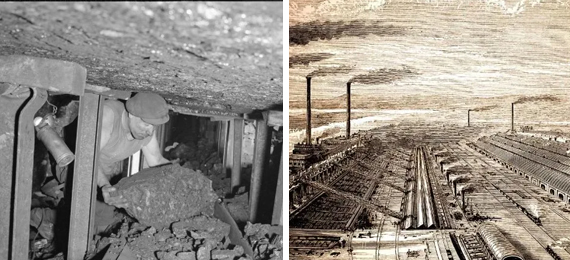
The driving force behind Britain’s Industrial Revolution was king coal, also known as the “black gold.” The British economy witnessed tremendous expansion, thanks to the Industrial Revolution. The main power source for the new machinery for the expanding factories and for the steam engines throughout the industrial revolution was coal, which was in great demand. Steam engines were a welcome development as they accomplished tasks that humans and animals couldn’t. Back then, coal production in Britain was at its peak. The country produced 5.2 million tons of coal in the 1750s, according to estimates. However, by 1850, Britain 62.5 million tons annually, a significant increase from the previous era.
Although coal helped England’s economy grow, mining the mineral was difficult. The miners were mostly males and children older than nine years old. They were paid very little for their 10-hour shifts and typically lived close to the coal mining area. For ten hours of life-threatening work, they received 1.50€, that is $1.60.
Over 2,696 coal mining fatalities were reported, according to a 1917 record. Natural gas leaks that choked workers, unexpected blasting due to the natural gas coming in contact with candlelight, and ceiling collapses were the usual leading causes of death. Workers were sent to mine underground due to the rising demand for coal. Miners frequently wore only their underwear due to the intense heat. Continue reading to know more about Welsh coal mining facts and the coal industry in Wales.
Coal is rich in _______
- A. Sulphur
- B. Carbon
- C. Oxygen
- D. Boron
Welsh coal mining facts
Southern Wales discovered the abundant coal reserves in the Rhondda and Cynon Valleys in the middle of the 19th century. 13 million tons of coal were produced by 1870, which was a very high production rate. In order to work in the coal mines, immigrants began to move to Wales. Coal mining replaced even agriculture. The majority of the immigrants came from the English Midlands, Scotland, and Ireland. Coal mining in Wales was so deadly that one person would die every six hours and one would suffer a serious injury every 12 minutes. Due to the significant migration, the population in the regions where coal is mined dramatically increased.
Coal mines in Wales to visit
If you want to see the coal mining sites and learn about the equipment that was once employed, Wales is the finest destination. The two must-see locations in Wales are Rhondda Heritage Park and South Wales Miners Museum.